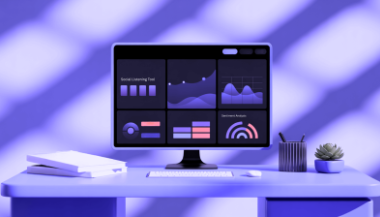How Marketers Can Use Call Flow Designers to Drive Better Conversions

Every call matters in marketing. Each second on the phone shapes the customer’s decision and experience. That’s where call flow designers step in. They dictate where calls will go, who picks up the phones, and what they listen to.
The innovative use of the call flow designer can help your business gain additional trust, reduce drop-offs, and improve your conversions. So, how can marketers utilize this tool to achieve improved outcomes?
Let us take a stroll through the process.
Understanding Call Flow Designer
A call flow designer is a visual tool that traces the route a phone call goes through. It determines what occurs once a person dials your number. This may be in the form of greeting, menu services, or direct transfers. Think of it like setting up a journey for every caller. You get to control each step of that journey. This makes sure no call gets wasted or lost.
Good call flows don’t confuse people. They feel natural, easy, and fast. Customers hate delays or wrong transfers. A smart flow avoids those issues. It helps you connect people to the right agent or information in an instant. Marketers can use this to capture attention and build stronger customer experiences. That alone makes it a tool worth exploring.
Creating a Smooth Caller Experience
Your first goal should always be simplicity. A call that’s too complex pushes people away. When using a call flow designer, start with a simple greeting. A friendly tone helps build trust right away. Then guide callers based on their needs. Provide some choices to choose from. Too many options may become counterproductive.
Use recorded prompts if needed. Ensure that your responses are kept short and polite. Avoid heavy technical words. The caller wants help fast. Every second counts during a call.
You can also add a fallback option. This connects them to an agent if they get confused or have complex issues. These small moves help reduce frustration. In marketing, less friction always means more conversions.
Personalising the Flow for Better Results
Not every caller is the same. Some want support. Others are ready to buy. A few may just have questions. That’s why custom flows work better than generic ones. Use caller data to make the experience feel personal. If someone calls from a particular location, route them to a local agent. If they’ve called before, greet them by name.
You can even trigger different flows during campaigns. Let’s say you’re running a product offer. You can set up a special route for callers who respond to it. That way, they hear a message that matches the ad they saw. This level of detail can lift your conversion numbers quickly.
Matching Call Flows With Campaign Goals
Each campaign has a different purpose. Some aim to drive signups. Others focus on product demos or support calls. Your call flow should match that purpose. If the goal is conversion, your flow should move callers toward sales fast. No long menus. No hold music. Just quick access to the right agent or message.
If it’s a feedback campaign, let them record comments easily. If it’s about upselling, use the flow to share upgrades before a live agent answers. These tweaks ensure each call supports your goal, not distracts from it. Marketers often forget this link. Aligning call flows with goals can bring surprising results.
See also: The Role of Technology in Modern Trading Platforms
Using IVR to Reduce Drop-Offs
Interactive Voice Response, or IVR, is part of most of the flow builders. It lets callers respond using keypresses or speech. This can reduce the time spent on each call. It also helps direct them to the right agent quickly. But it has to feel natural. Don’t overload callers with too many options. Three or four is enough.
Also, test your IVR messages. Are they too long? Too formal? Too confusing? A simple message works best. “Press 1 for sales, 2 for support” is clear and fast. The less effort needed from the caller, the more likely they’ll stay. This means fewer hang-ups and more completed calls.
Tracking Every Step for Improvement
Call flow designers often come with reports. These show where callers drop off, how long they wait, and what options they choose. This is a goldmine for marketers. It tells you what’s working and what’s not. Maybe too many people hang up during the menu. Or maybe no one presses the “promotions” option.
Use that data to refine your flow. Try shorter intros. Test a different order of options. Also, remove features people don’t use. You’ll be surprised how a small tweak can improve engagement. This constant loop of testing and improving leads to better conversions over time.
A/B Testing Different Call Experiences
Marketers love A/B testing. You can do the same with call flows. Test two different greetings. Try different routing strategies. Use different hold music or callback options. See what brings better results. Don’t guess what works. Let the numbers guide you.
Some flow designers offer real-time switching. You can roll out a new flow without downtime. This makes it easier to experiment. With time, you’ll find the layout that brings in the most conversions. That’s the power of call experience testing.
Using Smart Routing to Reduce Wait Times
Long wait times kill conversions. Smart routing fixes that. It sends each call to the best person available. This might be based on time, skill, language, or location. You set the rules. The system follows them. Everyone gets the right help faster.
Nobody wants to be referred to some agent after another. This wastes time and creates frustration. Marketers can stop that using routing rules. Better routing means better calls. And better calls mean higher conversions.
Integrating CRM and Call Flow Tools
Many flow designers work with CRM systems. This makes personalisation easier. When someone calls, the system checks their profile. Then it can greet them by name or show the agent’s past interactions. This makes the call feel more helpful and warm.
Agents don’t need to ask for repeated details. The call flow already filters that out. This kind of integration improves customer trust. People feel known and valued. That’s the emotion behind most buying decisions. Marketers who understand this witness an increased conversion rate. Plus, access to call history through CRM adds more context to every conversation, leading to better results.
Reducing Human Errors with Automation
Manual call routing leads to mistakes. Wrong call transfers and long hold times frustrate people. Automating the flow reduces these problems. The well-defined paths and rules allow the system to be fully aware of where each call needs to be redirected.
Another way of using automation is through follow-up texting or email. The system follows up by sending a thank-you note or a product link upon making a call. This continues the discussion even when the call is gone. It is a low-key but effective method of developing leads.
Staying Consistent Across All Campaigns
It is important for you to be consistent. The tone, message, and voice should feel stable across channels. Call flows are part of it. Whether someone sees an ad or makes a call, the experience should connect.
Marketers can use the same messages from campaigns in their call prompts. This enhances the offer or the brand value. When people have a smooth brand experience, they will trust brands easily. And trust leads to conversions.
Scaling Call Management as You Grow
As marketing campaigns grow, so does call volume. Call flow designers scale with your business. You can add new rules, routes, or agents easily. No need to rebuild from scratch. Just adjust the map as needed.
This flexibility helps marketers stay agile. A holiday promo may need special routing. A new product line might need a new menu option. The ability to handle concurrent calls ensures the system works smoothly during peak periods. The designer tool lets you adapt without much technical help. That means faster execution and smoother campaigns.
Helping Teams Collaborate More Easily
Most call flow tools allow team collaboration. Marketing, support, and sales can work together. This makes it easier to align goals. No one builds flows in isolation. Everyone contributes to shaping a better caller journey.
This also reduces errors and miscommunication. Everyone can see how the call journey works. This shared understanding leads to a better experience for your customers.
Making the Most of Every Single Call
Calls are direct connections with your audience. Each one offers a chance to engage, persuade, and convert. With a good call flow, you don’t waste those chances. You guide callers quickly and smoothly to the right place.
Marketers who use call flow designers with intent see clear benefits. More satisfied callers, better brand experiences. And, most importantly, more conversions. Every piece of the call matters.
Final Thoughts
Marketing isn’t just the advertisement that you see. It continues with every customer interaction. Call flows are part of that journey. With a good call flow designer, you shape how people feel when they contact you. That feeling decides what they do next.
Keep testing. Keep improving. A great call experience today builds loyal customers tomorrow. Make every call count.




